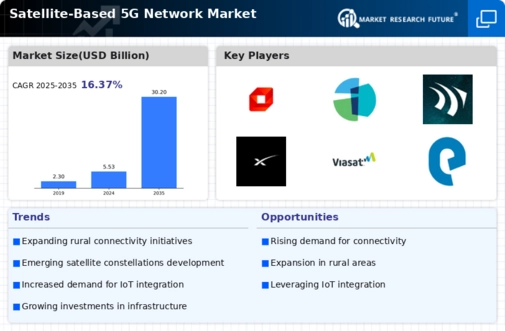Advancements in Satellite Technology
Technological advancements in satellite systems are significantly influencing the Satellite-Based 5G Network Market. Innovations such as low Earth orbit (LEO) satellites are enabling faster data transmission and reduced latency, which are critical for 5G applications. The deployment of these advanced satellite systems is projected to enhance global connectivity, making it feasible to deliver high-speed internet to remote regions. Furthermore, the integration of artificial intelligence and machine learning in satellite operations is optimizing network performance and resource allocation. As these technologies continue to evolve, they are likely to drive growth in the Satellite-Based 5G Network Market, providing more efficient and effective solutions for users.
Growing Adoption of IoT Applications
The proliferation of Internet of Things (IoT) applications is a significant factor propelling the Satellite-Based 5G Network Market. As industries increasingly adopt IoT technologies for automation and data collection, the demand for reliable and high-speed connectivity becomes critical. Satellite-based networks can support a vast number of connected devices, making them ideal for IoT applications in agriculture, transportation, and smart cities. The market for IoT is projected to expand rapidly, with billions of devices expected to be connected in the coming years. This trend is likely to create substantial opportunities for the Satellite-Based 5G Network Market, as it seeks to provide the necessary infrastructure to support this growing ecosystem.
Increased Demand for High-Speed Internet
The Satellite-Based 5G Network Market is experiencing a surge in demand for high-speed internet services. As more individuals and businesses rely on digital connectivity, the need for faster and more reliable internet access becomes paramount. According to recent data, the number of internet users has reached approximately 5 billion, indicating a growing market for enhanced connectivity solutions. Satellite-based networks can provide coverage in remote and underserved areas, addressing the digital divide. This demand is further fueled by the rise of IoT devices, which require robust connectivity to function effectively. The Satellite-Based 5G Network Market is thus positioned to capitalize on this trend, offering solutions that meet the increasing expectations for speed and reliability.
Regulatory Support for Satellite Communications
Regulatory frameworks are evolving to support the expansion of satellite communications, which is beneficial for the Satellite-Based 5G Network Market. Governments are recognizing the importance of satellite technology in achieving universal connectivity and are implementing policies that facilitate the deployment of satellite networks. This regulatory support includes streamlined licensing processes and incentives for investment in satellite infrastructure. As these frameworks become more favorable, they are likely to encourage further innovation and investment in the Satellite-Based 5G Network Market. The alignment of regulatory policies with technological advancements may enhance the overall growth trajectory of the market.
Rising Investment in Telecommunications Infrastructure
Investment in telecommunications infrastructure is a key driver for the Satellite-Based 5G Network Market. Governments and private entities are increasingly allocating funds to enhance connectivity, particularly in rural and underserved areas. Recent reports indicate that investments in satellite communications are expected to reach billions of dollars over the next few years. This influx of capital is facilitating the development and deployment of satellite-based 5G networks, which can provide essential services where traditional infrastructure is lacking. As a result, the Satellite-Based 5G Network Market is likely to see accelerated growth, driven by the need for improved connectivity solutions.


















Leave a Comment